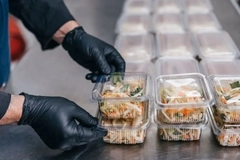Pont’s supply chain director: E-commerce’s environmental and financial impacts demand mindset shift

19 May 2023 --- The hidden costs of international logistics go beyond the environmental impact, which is a reason in itself to reduce transportation. The European Union Environment Agency states that, between 2000 and 2019, the demand for freight transport in Europe increased by 22%, with road transport accounting for 77% of the continent’s greenhouse gas emissions.
When you add practical costs like time, accessibility and the peace of mind of getting your order exactly when you want it, it makes common sense – and commercial sense – to cut transportation costs wherever possible. But how?
Consumers expect quick deliveries now, and this trend is increasing. Retail Technology Review published findings that state 43% of consumers chose next-day delivery, up 4% from the previous year, and last-mile delivery means that same-day delivery is expected in many cities already.
At what cost is this instant gratification? And who is going to stop the “progress?” Who doesn’t want something delivered quickly anyway, now that we’re all used to it – whether we’re consumers, packaging experts or both?
Factoring in the environment
Max van de Grift, supply chain director at Pont, a European glass, plastic and bioplastic packaging supplier to the F&B, nutrition and personal care industries, is clear that there is a two-pronged answer that ticks both the environmental and commercial boxes. Pont Packaging’s supply chain director Max van de Grift.
Pont Packaging’s supply chain director Max van de Grift.
“There has become an expectation that shipping is free when consumers buy online, but it’s never free. The financial cost is built into the price, but the environmental cost is not yet properly considered,” he says.
“Logistics companies and major brands are talking about their sustainability actions and targets, but it’s not a deterrent yet. So one element of the answer is to change expectations, which might mean consumers don’t choose next-day shipping if they don’t actually need the item the next day.”
The second element is to look at where you’re buying from. E-commerce portals make it all too easy for consumers to quickly compare price and speed of delivery, but as that doesn’t consider the hidden costs, it makes it seem like the cheapest and the quickest is the best value.
But when did environmental cost stop being considered as part of the value?
Understandably, the cost-of-living crisis hitting parts of Europe means that, for many, price really is the only deciding factor at the moment. But even so, we don’t always need the item the next day.
Building in a margin
Van de Grift continues: “There’s certainly a domino effect, whether that is of good or bad decisions. When you overload the rail or roads, as is the case across Europe in recent years and particularly since COVID, there is no margin. If there is the slightest issue, there is quickly a massive problem.”
“And yet, that domino effect when consumers pick delivery in a week rather than next-day, means that there is less pressure on the roads. And people still get what they need.” Shoppers can play their part to reduce environmental impact by only using next-day delivery when essential.
Shoppers can play their part to reduce environmental impact by only using next-day delivery when essential.
One solution is to buy local, not just for fruits and vegetables (even though that sector has done a great job in raising awareness of the issue), but for practically anything. For example, the Netherlands is reportedly the fifth largest importer of bovine meat in the world, yet it also exports 70% of its local meat production.
As supply chain director of a packaging producer, van de Grift is well aware of creating a positive balance between keeping customers happy and operating responsibly. He shares how he marries the two energies: “Pont has 14 local distribution centers across Europe, so we can quickly deliver a range of standardized and customized products to customers wherever they are.”
“We can optimize our transportation by staying close to our customers and understanding where each of our distribution centers is delivering to and when. We take great care to utilize our truckloads with full pallets, and we talk to our customers to know when they need a delivery.”
Optimizing transportation
Optimizing transportation is a common B2B logistics challenge. Many customers need to send their orders fragmented as that’s how their systems and their business work.
Van de Grift suggests that this is managed in a smart way to avoid shipping and handling each order separately, but still delivering on time and as required, by handling specific customers’ orders on an agreed day of the week, then shipping them out combined the next day. Consumers can also reduce carbon emissions by shopping more locally.
Consumers can also reduce carbon emissions by shopping more locally.
“This strategy avoids many transports with small quantities during the week. The advantage for the customer is that they do not have to handle all incoming flows, plus it’s more effective and sustainable,” he explains.
Direct deliveries also support a more sustainable supply chain, with Pont constantly reviewing the most efficient delivery depending on the distance from the manufacturing point, taking all handling elements into consideration and taking out any unnecessary steps for both cost and environmental advantages.
This balance means that e-commerce expansion can be embraced without putting unnecessary strain on the transport network. Local deliveries keep journeys as short as possible, and local representatives know the specific and ever-evolving regulations around paperwork for packaging.
“It’s about slowly changing the mindset of people for everyone’s advantage. We can’t control people’s behavior, but we can offer viable alternatives, like increasing bio-based materials, offering different delivery times and promoting local distribution centers with people that know the issues local customers are facing,” adds Van de Grift.
“It’s an exciting challenge as it’s for the benefit of us all.”
By Maggie Lonsdale











